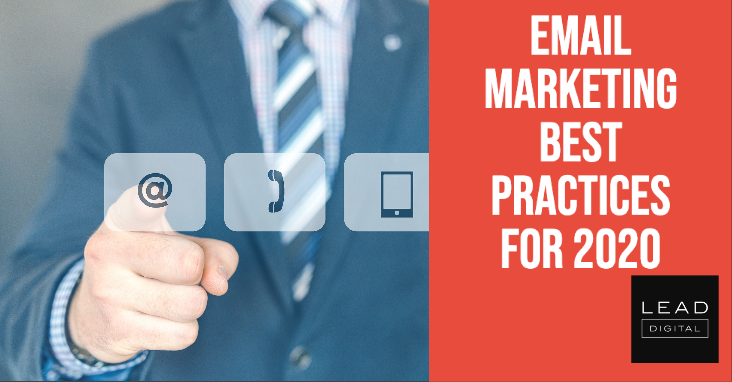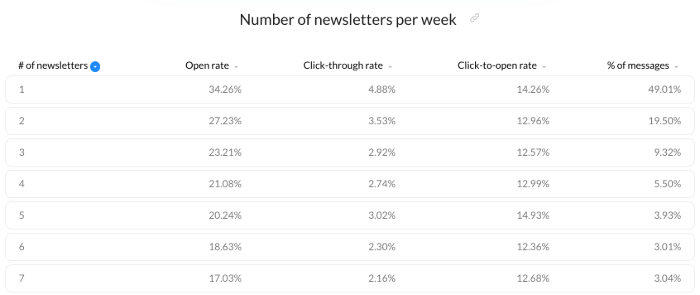 Whether you’re new to email marketing or consider yourself an expert, you likely want the same: to send the best email marketing campaigns.
Whether you’re new to email marketing or consider yourself an expert, you likely want the same: to send the best email marketing campaigns.
If you’re just getting started, read our beginners guide to email marketing first.
Already know your way around?
Read on and follow these 21 email marketing best practices that’ll keep your customers engaged, improve your ROI, and get your campaigns going in 2020 and beyond.
1. Use welcome emails to build strong relationships and deliverability
The welcome email is the single most effective message you can send.
According to our latest data, average open rates soar above 80% – and click-through rates are around 22-25%.
Welcome emails also help keep your list clean and improve your email deliverability. If someone enters the wrong email address, the welcome email will generate a hard bounce. That then notifies your email provider to remove it from your list.
They also reassure your new email recipients that the signup worked, and the information they want is on its way.
Plus, they help you connect with new subscribers. Offer something valuable or exclusive at the start of their journey and watch click-throughs rise.
Read more: What is email deliverability


Bonus: Free Guide
Want more people to open, click, and respond to your email campaigns?
Grab our free guide and learn the 20 quick ways you can increase your key email marketing metrics.
2. Send emails at the right time to increase your conversion rate
Every email marketer wants their newsletter to be at the top of the inbox.
After all, most subscribers will pick the emails they see first.
So when should you send your emails? Let’s see what the data tells us.
Two timeslots tend to get the best average email open rates and CTRs: 9-11am and 3-5pm. And it’s been that way for at least the last two years.

When it comes to picking the right day, it doesn’t seem to make a huge difference. As long as you stay away from the weekend, your engagement rates should be fine.

Having said that, you need to remember that these are aggregate global results that take into account every industry we’ve identified in our customer base.
Chances are, your audience will respond to campaigns sent at a different time. It depends on your market, consumer trends, and your customers’ preferences.
Want to step up your game? Use tools like Perfect Timing and our algorithm will pick the best time to send your messages.
3. Get the frequency right to grow a healthy and engaged list
Another email marketing best practice is knowing how often you should contact your subscribers.
And that can be a tricky task.
If we look at the mailing frequency data, we see that email marketers who send just one newsletter a week get the highest average open and click-through rates.
It’s a popular approach since 49% of all accounts we analyzed only send one newsletter a week. Bear in mind this data doesn’t exclude marketers who also send triggered emails or RSS emails.
What about other frequencies?
Around 19.5% send two newsletters a week, and 9.32% send three. Just 5.5% and 3.93% send four and five emails respectively.

At the same time, since most marketers want to maximize their email campaign ROI, instead of average CTRs we should look at the total number of conversions they generate.
Based on that assumption, you might be better off sending two or more emails in the same week.
But to say for sure, we must take into account some other factors: extra revenue you’d make from sending an extra campaign, how many subscribers would leave your list after receiving too many messages, plus the cost to replace those leads.
In fact, one study, conducted by Return Path in 2015, focused on the consquences of both undermailing and overmailing.

In short, undermailing leads to missed revenue opportunities, lower lifetime value, lack of inbox presence, poor or inconsistent sender reputation, inability to maintain a clean list and avoid spam traps, and counterintuitively – increased complaint rates.
Overmailing, on the other hand, leads to decreased engagement, increased opt-outs, reduced visibility for all subscribers, and more total complaints.
As for the most optimal mailing frequency, there wasn’t one clear winner.
The primary email recipients (those who accounted for 83% of all email reads), were able to tolerate up to about five emails per week from a given sender before their complaint rates increased dramatically.
If you ask me, that number is a bit extreme and I wouldn’t suggest that you go out and start sending your email campaigns five times per week.
This all depends on your market and products.
Divide your audience into two or more groups, and see if sending one extra email campaign boosts your results – both in the short and long term.
In his article, Tim Watson dives deeper into how you can establish the right mailing frequency for your business.
If you’re not interested in experimenting, you can also ask your audience to manage their own frequency, using an email preference center.
Remember that while it’s easy to control how often you email, it’s often harder to see how many triggered emails are sent to your contacts each week – especially if they’re sent in response to an action.
4. Watch your deliverability and avoid the spam folder
Email deliverability is crucial to your campaign success. It doesn’t matter how interesting or beautiful your emails are. If subscribers never see them, they won’t convert.
Many marketers think only their email service provider handles email deliverability. But it goes beyond that.
Your email content, frequency, and list-building methods all impact your deliverability.

All the email campaigns best practices mentioned in this article will help improve your performance. But you should especially keep an eye on:
– How email deliverability works and how to improve it.
– Key reasons why your emails go to spam and what you can do about it.
5. Use a memorable sender name
First impressions matter.
And in email marketing, it can also be the last one you make.
If your email doesn’t stand out and build trust, your subscribers probably won’t bother opening it.
And if they ignore your newsletters a few times, your future campaigns could go straight to junk.
That’s why paying attention to your sender name is an email marketing best practice.
Think of it as your brand name.
Your customers should respond well to it. They’ll then check out the subject line and preheader – or open the email right away.
So how do you do that?
First, your sender name should be recognizable and memorable.
You also have to offer value. Always. This article has plenty of tips for that, so let’s focus on making your sender name identifiable.
Most brands use one of the following formats:
– [Brand Name]
– [Employee Name] from [Brand Name]
– [Employee Name] @ [Brand Name]
– [Brand Name] Customer Support
– [Brand Name] Newsletter
– [Brand Name] Digest
Here are some real examples from my inbox:

As far as we’re aware, no-one has ever studied which one works best.
It seems to be a matter of preference – and what suits your brand voice guidelines.
If you have a strong employee with a good personal brand who’s associated with a particular campaign, you could use the combination of [Employee Name] from [Brand Name].
Example: Abby from GetResponse
Topic: New upcoming webinar
But that might not work for B2B, when it’s more important for the communication to come from the brand itself.
Example: McKinsey
Topic: Mobile Ecommerce Trends in EMEA
So take these ideas, compare them with your brand voice guidelines, and A/B test them.
Then stick to the one that works.
Over time, people will get used to seeing the same name. So if you change it later on, they might not immediately connect it with your brand.
You also have to think about the sender address.
Why?
Because it builds its own reputation over time – in the eyes of ISPs.
Changing it too often can affect whether your recipient’s email provider accepts your emails.
To avoid problems with your email deliverability, don’t change it too often, send from a company domain (not freemail like Gmail or Yahoo), and use a trustworthy address.

6. Be authentic, seek feedback and ditch the noreply@ address
The noreply@ addresses is a little ironic.
Most marketers will swear their customers are at the center of their business.
That they care about their opinions and feedback, both positive and negative.
And then, after earning their trust and convincing them to complete an opt-in form, they use an email address that straight-out says:
“We don’t care enough about you to check this inbox.”
I get it. The sheer volume of auto-reply and out of office messages can often be overwhelming. And sometimes your email doesn’t seem like something people will respond to.
But your customers might see things differently.
Don’t make it harder for them to give feedback.
You probably have business profiles on Twitter, Facebook, and LinkedIn – all to be where your customers are. And to be available.
It’s the same with email marketing.
Who knows, maybe those who care enough to hit reply will be your best brand ambassadors.
The benefits of ditching the noreply@ address outweigh the negatives. – Read more



